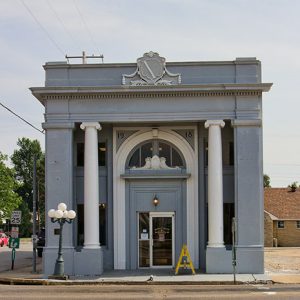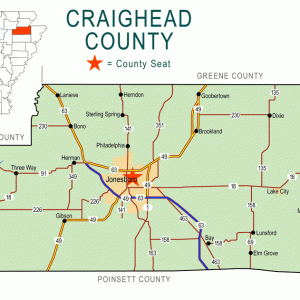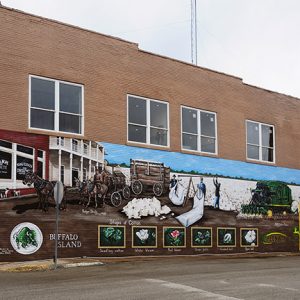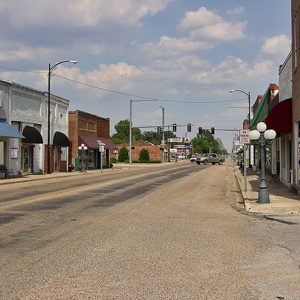calsfoundation@cals.org
Monette (Craighead County)
| Latitude and Longitude: | 35º53’36″N 090º20’39″W |
| Elevation: | 236 feet |
| Area: | 5.66 square miles (2020 Census) |
| Population: | 1,506 (2020 Census) |
| Incorporation Date: | July 3, 1900 |
Historical Population as per the U.S. Census:
|
1810 |
1820 |
1830 |
1840 |
1850 |
1860 |
1870 |
1880 |
1890 |
1900 |
|
– |
– |
– |
– |
– |
– |
– |
– |
– |
559 |
|
1910 |
1920 |
1930 |
1940 |
1950 |
1960 |
1970 |
1980 |
1990 |
2000 |
|
1,066 |
1,066 |
1,111 |
1,074 |
1,114 |
981 |
1,076 |
1,165 |
1,115 |
1,179 |
|
2010 |
2020 |
|
|
|
|
|
|
|
|
|
1,501 |
1,506 |
|
|
|
|
|
|
|
|
Monette in Craighead County is one of the principal cities in the region of northeastern Arkansas called Buffalo Island. Founded when the railroad was built across the region around the beginning of the twentieth century, Monette quickly became an agricultural center and later added light industry, surviving the economic changes that have sent so many similar cities in Arkansas and other southern states into decline.
Buffalo Island was shaken by the New Madrid Earthquakes of 1811–1812, causing much of the land to sink and become swampland. The hardwood forests and marshy areas made travel and settlement difficult, but a few families made their homes in the region during the nineteenth century. Arnold Stotts (some sources show the name as Stott) acquired high land in the Buffalo Island area and, with his family, moved there from Crowley’s Ridge in 1853. He grew the first cotton in the area and built his own cotton gin, grist mill, and sawmill. He opened a store in 1874 to meet the needs of hunters and trappers moving through the area as well as those of the few settlers who had joined him in the wilderness. A post office was established at his settlement, which he named Stottsville. The post office closed a few months later but was reopened in 1886. He also established a school on his property in 1881.
In 1898 the Jonesboro, Lake City, and Eastern Railroad was built through Buffalo Island. The tracks came within a mile of Stottsville, and the settlers and business owners of the community decided to relocate next to the railway. Four men—James Nance, William Stotts, Sam Stotts, and Joshua Lairson—each donated nine acres for the new city. Local lore holds that the city was named either for the wife or the two daughters (Mona and Nettie) of a railroad official, but no such names appear on census records. More likely, the city was named either for Monette, Missouri, or Monette, Mississippi, though the settlers hailed mostly from Kentucky and Tennessee. The first train reached the city of Monette on August 19, 1898.
The first general store was opened in Monette by J. M. Hatcher and C. A. Gregson. Needham Harvey Grady, the first doctor to live in the city, had a combination mercantile and drugstore. J. E. Blankenship also had a store in the city. Other stores were added, as well as the Bank of Monette, two hotels, three churches (Christian, Methodist, and Baptist), a school, and several sawmills. W. O. Troutt, a Jonesboro (Craighead County) publisher, started the first newspaper, the Monette Sun. Three fires devastated the city in 1912—two in January and a third in December. Businesses were rebuilt, and the city continued to prosper. A third hotel, with a large lobby, a restaurant, and eighteen spacious rooms, opened in January 1918. It operated continuously until it was destroyed by fire in 1931. With help from the Public Works Administration (PWA), the Monette Water Tower was built in 1936.
At first, the primary industries of Monette were timber and cotton. By 1920, most of the hardwood had been harvested from the region, and cotton prices plummeted following the high-demand years of World War I. W. T. Lane Jr., a banker and farmer, began to grow cantaloupes, which were shipped by rail to St. Louis, Missouri, and Chicago, Illinois. His success with this crop prompted Lane to experiment with radishes. Until the Depression, this kind of agricultural experimentation sustained the economy of Monette. During the 1950s, Monette was known for its strawberries, and watermelons have been grown in the area more recently.
Monette also became known for a semiprofessional baseball team, the Monette Buffaloes. Local sources claimed that their baseball tournament in Monette in 1930 was the first semi-pro tournament in the United States.
In 1930, the school building and gym burned to the ground. Because of the struggling economy, two years elapsed before the school was rebuilt. A volunteer fire department was established in 1947, although it did not acquire a fire truck until 1953.
Monette’s first industrial plant was built in 1957. Electrolock Incorporated manufactured parts for automobile air conditioners and employed up to fifty workers. After that plant was closed, the building was acquired in 1969 by Frolic Footwear, which employed as many as 175. Other manufacturing industries, including the Colson Wheel Plant and Countryside of Monette, also opened in the city.
Following several rounds of school consolidation in Arkansas, the Buffalo Island Central School District was established in Monette in 1984. As of 2013, the district includes two elementary schools, a junior high school, and a senior high school, educating more than 800 students. The population of Monette in the 2010 census was 1,501. Most of the residents are white, although eighty-five are listed as Hispanic.
Monette attracted international attention when, on December 10, 2021, a large tornado struct the town, significantly damaging Monette Manor, a nursing home, and killing one person. The tornado was part of a larger storm system that affected several states. A tornado outbreak on April 2, 2025, damaged several homes and other structures in Monette.
Longtime state legislator Tom Watson was born in Monette. “Jim Dandy” Mangrum attended high school in Monette. Mangrum and his friends started the band Black Oak Arkansas, which had a successful recording and concert career in the 1970s and continued performing in the twenty-first century.
For additional information:
Eaton, Hershel “Plug.” “Monette, Arkansas, the Capital of Buffalo Island.” Craighead County Historical Quarterly 19 (April 1981): 4–16.
Ellis, Dale. “Survivors Weigh Storm’s Toil.” Arkansas Democrat-Gazette, December 13, 2021, pp. 1A, 8A. Online at https://www.arkansasonline.com/news/2021/dec/13/northeast-arkansas-tornado-victims-recall-storms/ (accessed February 28, 2025).
Lancaster, Grant. “Nursing Home Struck in Storm; 1 Person Dies.” Arkansas Democrat-Gazette, December 11, 2021, pp. 1A, 7A. Online at https://www.arkansasonline.com/news/2021/dec/11/nursing-home-struck-in-storm-1-person-dies/ (accessed February 28, 2025).
Reves, J. Allen. “Monette’s Commercial and Sports History.” Craighead County Historical Quarterly 19 (July 1981): 3–10.
Steven Teske
Butler Center for Arkansas Studies
 Buffalo Island Museum
Buffalo Island Museum  Craighead County Map
Craighead County Map  Monette Mural
Monette Mural  Monette Street Scene
Monette Street Scene  Monette Water Tower
Monette Water Tower 



Comments
No comments on this entry yet.